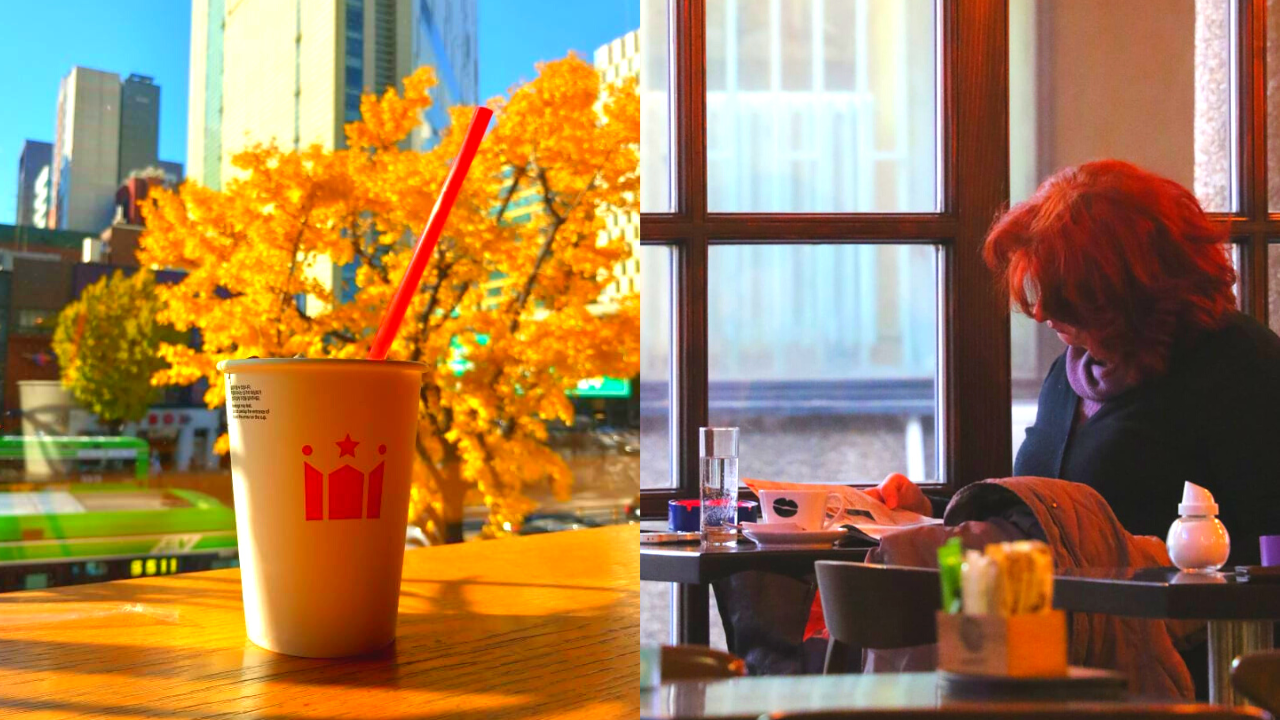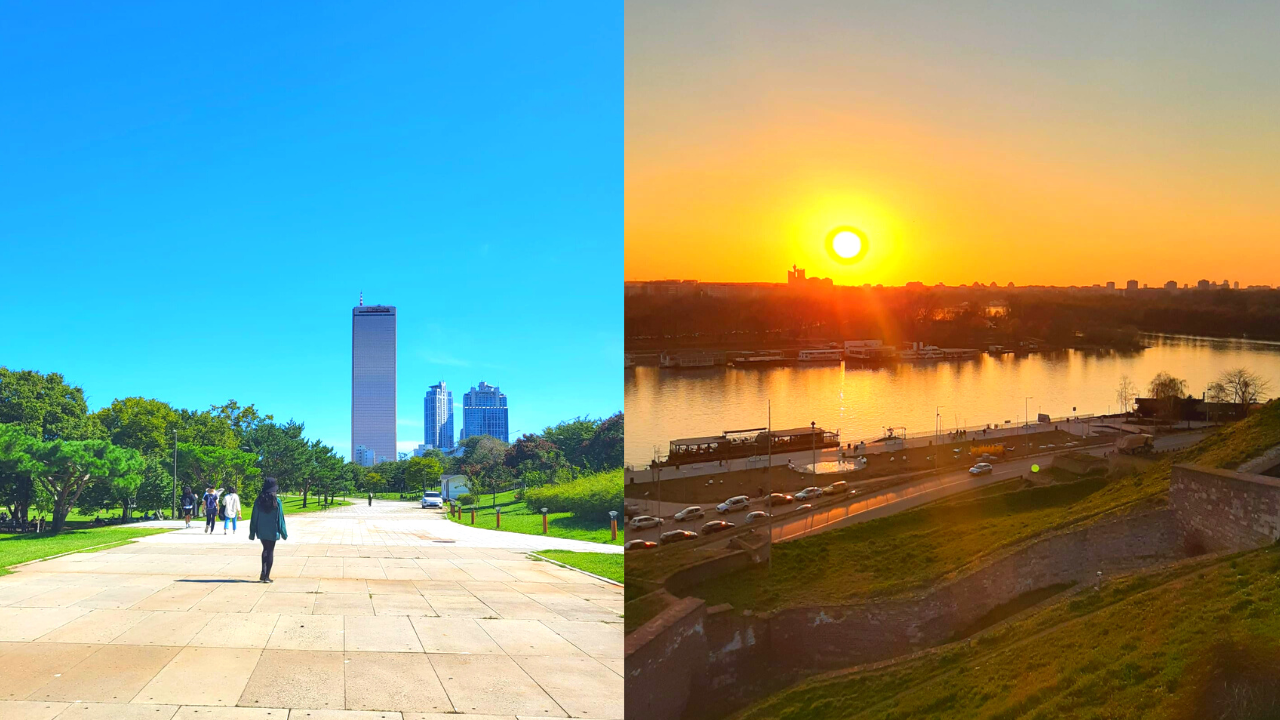- 한국어
- English
- 日本語
- 中文
- العربية
- Español
- Français
- Deutsch
- Pусский
- Tiếng Việt
- Indonesian
By Honorary Reporter Jovana Svedic from Serbia
Korea and Serbia have many cultural differences, and while traveling to the former, I tend to look for similarities between both countries, especially between their capitals Seoul and Belgrade. During this quest, I discovered that both cities are not as dissimilar as I initially thought. So here are my thoughts on the similarities and differences between my two favorite cities, with the photos displayed taken in September last year.

The coffee shop on the left is in Seoul and that on the right is in Belgrade. (Elena Tadic and Jovana Svedic)
Belgrade is known for its many coffee shops and coffee-drinking culture. Every street corner there has a cafe with themes ranging from modern art designs to those highlighting the venue. Seoul also has plenty of places to get a good cup of coffee but boasts far more sophisticated and simplified versions of coffee shops than those in Serbia.
Also in Seoul, themed cafes offer specific types of coffee such as Americano or black sesame, with fewer options in one place but of better quality. In Belgrade, more items are on the menu, from plain black coffee to cocktails and whiskeys, but the quality can vary depending on place. A person there can spend up to two to three hours doing remote work, attending business or private meetings, and even eating breakfast or lunch in the meantime. If a familiar face appears, it is common to switch or join tables and enjoy time with him or her.
The Korean capital's coffee-drinking culture is more about experiencing the art of coffee making and incorporating it into the daily routine, while in Belgrade, cafes are where people come together and network from early morning until late evening.

Yeouido Hangang Park in Seoul is shown on the left and Usce Park at Kalemegdan Fortress in Belgrade on the right. (Jovana Svedic and Lola Lazovic)
The abundance of small and slightly larger parks is what I love most about both cities. From basking in the sun and spending quality time with family and friends to hiking and biking on trails, the two capitals have parks that are must-see attractions when visiting.
Their only difference? Scale.
Olympic Park, one of Seoul's largest, is over twice the size of Belgrade's biggest Kalemegdan Park. What both venues have in common is their historical and cultural significance to the people of both countries, not just city residents. Olympic Park was built on the site of Mongchontoseong Fortress of the early Baekje Kingdom and the artificial lake Mongchonhaeja. Kalemegdan Park was built within the still-standing walls of Kalemegdan Fortress, Belgrade's main military stronghold, before becoming a park in the 1870s that now hosts numerous festivals, exhibitions, concerts and other events.
Yeouido Hangang Park in Seoul and Usce in Belgrade also have a connection as both are located on a riverbank and popular with tourists looking to unwind and take in the sights of the capital. On a visit to Korea in September last year, I made the Yeouido park one of my first stops, and it immediately reminded me of the atmosphere at Usce, which is also a great place to spend time with family or biking, skating or doing other activities while enjoying a nice meal on a sunny day.
Festivals and concerts are two more items that connect both parks. The Yeouido Mulbit Stage, the world's largest floating stage with a retractable roof, is the closest thing to what Serbians call a "splav." Like the stage, a splav is a place for listening to music but can also be a nightclub, restaurant or just a casual spot to hang out with a DJ spinning tunes over the summer. This is why Usce is a leading spot for tourists and Belgrade youth, making the city a major nightlife venue in Europe.

The Seoul cityscape (left) features more modern buildings, while that of Belgrade (right) has more traditional architecture. (Jovana Svedic)
Seoul is far more technologically advanced than Belgrade, making daily tasks easier and faster. Online payments, quick delivery, the subway as the main mode of transportation and much more are available. Belgrade is still adopting new technologies and a faster-paced lifestyle, so Seoul was a breath of fresh air for me at times. Everything can be found online and quickly delivered in the Korean capital while in Serbia, cyber operations gained popularity during the COVID-19 pandemic, especially e-banking, which was previously only popular among businesses.
Another intriguing find was the attention to clothing and appearance by Seoul residents. This inspired me to take better care of my own beauty routine and fashion. Everyone in Seoul seems to wear wonderful pieces according to the latest fashion trends, while in Belgrade, everyone has their distinct style, from loud statement pieces to plain t-shirts and sweats.
Each capital has soul and is magical and unique in its own right. From history and unique architecture to residents and their welcoming and fun nature, the streets of both Seoul and Belgrade seem to possess a life of their own.
msjeon22@korea.kr
*This article is written by a Korea.net Honorary Reporter. Our group of Honorary Reporters are from all around the world, and they share with Korea.net their love and passion for all things Korean.
